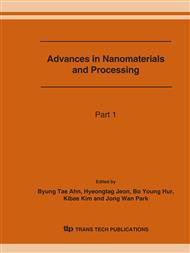p.355
p.359
p.363
p.367
p.371
p.375
p.379
p.383
p.387
Aligned Polycrystalline Silicon Array Thin Film by XeCl Excimer Laser Annealing for AMOLED Displays
Abstract:
Low temperature polycrystalline silicon (LTPS) thin film transistors (TFTs) are demanded to fabricate high performance liquid crystal displays (LCD) and organic light-emitting diode displays (OLED). The mobility of poly-Si TFT can be two orders of magnitude higher than that of amorphous Si (a-Si) TFT. Excimer laser annealing has been studied to be the most promising technology to meet the stringent requirement in high speed operation. The process parameters were identified as a-Si thickness, laser energy density, overlap ratio, annealing atmosphere and pre-clean condition. The a-Si layer of 40-50 nm was deposited by plasma enhanced chemical vapor deposition (PECVD). The XeCl excimer laser was irradiated on the a-Si film at room temperature under N2 or N2/O2 environment. The energy density ranged 250-400 mJ/cm2, and the overlap ratio was 95-99%. The highly aligned poly-Si array thin film could be obtained. The grain size has been about 0.31x0.33 μm2, and the regular arrangement in poly-Si grains was discussed. In addition, the PMOS TFT has been fabricated from the aligned poly-Si array. The mobility was as high as 100 cm2/Vs and the sub-threshold swing was around 0.24 V/dec. The threshold voltage was -1.25 V and the on/off current ratio was about 106.
Info:
Periodical:
Pages:
371-374
Citation:
Online since:
June 2007
Keywords:
Price:
Сopyright:
© 2007 Trans Tech Publications Ltd. All Rights Reserved
Share:
Citation:


